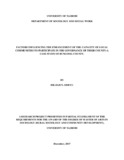| dc.description.abstract | Participation as a concept occupies a central place in governance and development. Kenya has moved in the past years from a centralized form of governance to a decentralized form as a result of the shortfalls of highly centralized forms of governance. These shortfalls included administrative inefficiencies and bureaucracies, misappropriation of the local resources and the marginalization of the local communities in the development processes. Devolution brought about by the 2010 Kenya Constitution seeks to enhance participatory governance through devolved structures at the county level. To empower the community to make the decision concerning their lives, governance and development several legislations have been put in place the key ones being the Constitution 2010. Despite all these, studies show that the level of public participation is still very low.
This study was conducted to establish the factors influencing the enhancement of the capacity of local communities to participate in the governance of their County. A case study of Bungoma County. Specifically it sought to: (i) to indicate the nature and extent of public participation in governance at the community level in Bungoma County, (ii) to find out the extent to which financial factors of the County influence public participation at the community level in Bungoma County, (iii) to establish the extent to which human resources factors in Bungoma County influence public participation at the community level, (iv) to examine the extent to which the County institutional framework influences public participation at the community level, and (v) to identify the key factors that enhance the capacity of local communities to get involved in decision making, governance and development initiatives.
The study which was conducted in Bungoma County used a descriptive survey research design and targeted members of communities in the County who were above the age of 18. Purposive sampling was used to select two sub counties one urban (Kanduyi) and one rural (Tongaren). Stratified random sampling was used to obtain the sample size for every ward and then systematic sampling was used to identify the respondents whereby every 10th household was sampled.
The study findings show a low level of public participation because of lack of awareness and limited information on public participation. There was also lack of enough resources to facilitate public participation and the allocated funds are not used appropriated. The County government has also adequate personnel to facilitate public participation however most of them lack the necessary skills and are not aware of their role in public participation. Although the County has a a public participation framework it is rarely followed and the public are not aware of it. The communities do not have the capacity to get involved in governance. The age, gender, education level, income level and attitude influence a person's capacity to get involved.
For communities to be involved, there is need to create awareness and sensitize the local communities, educate the people on their role and responsibility, establish interactive platforms at the various community levels, build up the people capacity and power to participate, and empower the County personnel on public participation. | en_US |



